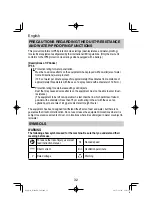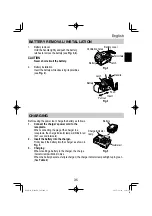
English
44
2. Cautions on use of the speed control switch
This switch has a built-in, electronic circuit which steplessly varies the rotation speed.
Consequently, when the switch trigger is pulled only slightly (low speed rotation) and the
motor is stopped while continuously driving in screws, the components of the electronic
circuit parts may overheat and be damaged.
3. Work at a tightening torque suitable for the bolt under impact
The optimum tightening torque for nuts or bolts di
ff
ers with material and size of the nuts
or bolts. An excessively large tightening torque for a small bolt may stretch or break the
bolt. The tightening torque increases in proportion to the operation time. Use the correct
operating time for the bolt.
4. Holding the tool
Hold the tool
fi
rmly with both hands. In this case hold the tool in line with bolt.
It is not necessary to push the tool very hard. Hold the tool with a force just su
ffi
cient to
counteract the impact force.
5. Con
fi
rm the tightening torque
The following factors contribute to a reduction of the tightening torque. So con
fi
rm the
actual tightening torque needed by screwing up some bolts before the job with a hand
torque wrench. Factors a
ff
ecting the tightening torque are as follows.
(1) Voltage
When the discharge margin is reached, voltage decreases and tightening torque is
lowered.
(2) Operating
time
The tightening torque increases when the operating time increases. But the tightening
torque does not increase above a certain value even if the tool is driven for a long time.
(3) Diameter of bolt
The tightening torque di
ff
ers with the diameter of the bolt. Generally a larger diameter bolt
requires larger tightening torque.
(4) Tightening
conditions
The tightening torque di
ff
ers according to the torque ratio; class, and length of bolts
even when bolts with the same size threads are used. The tightening torque also di
ff
ers
according to the condition of the surface of workpiece through which the bolts are to be
tightened. When the bolt and nut turn together, torque is greatly reduced.
(5) Using optional parts
The tightening torque is reduced a little when an extension bar, universal joint or a long
socket is used.
(6) Clearance of the socket
A worn or deformed hex. or a square-holed socket will not give an adequate tightness to
the
fi
tting between the nut or anvil, consequently resulting in loss of tightening torque.
Using an improper socket which does not match to the bolt will result in an insu
ffi
cient
tightening torque.
(7) Tightening torque varies, depending on the battery’s charge level.
000Book̲WR36DA̲ChS.indb 44
000Book̲WR36DA̲ChS.indb 44
2017/12/28 11:03:19
2017/12/28 11:03:19









































